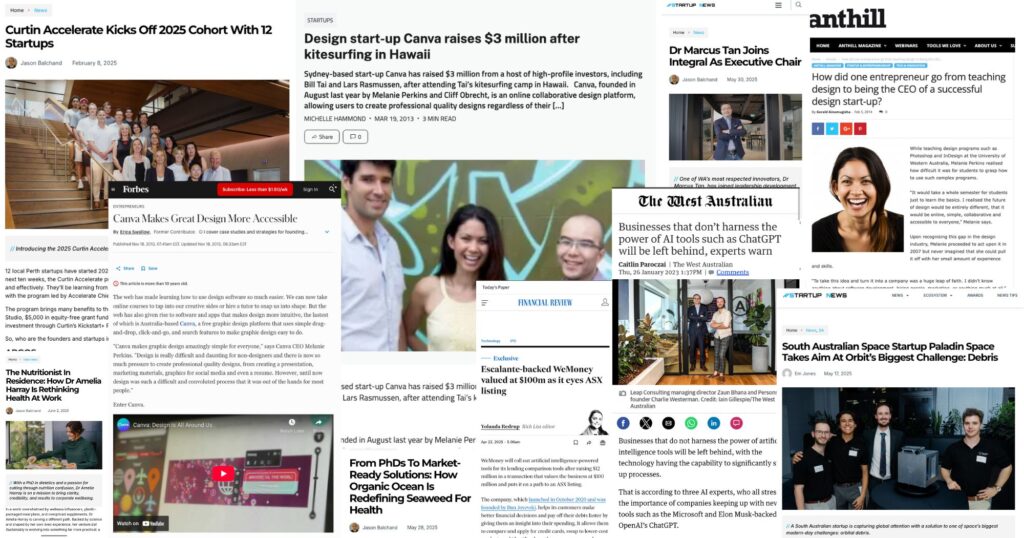In the world of startups, there’s a common — and costly — misconception that PR is something you do after you’ve made it. After product-market fit. After your Series A. After you’ve hired a head of marketing.
I’d argue the opposite: if you want to build a startup of consequence, your PR and media strategy should start much earlier than you think.
Not as an afterthought. Not as a vanity project. But as a core lever for growth, credibility, and long-term value.
I’ve seen this play out again and again — across local WA startups, national scale-ups, and even global players that began on our shores.
Escaping the founder echo chamber
In the early days, it’s natural for founders to live inside the product. You’re shipping features, talking to early customers, and trying to raise capital. The idea of talking to media or “doing PR” can feel like a distraction.
But the truth is: no matter how good your product is, if no one knows about it, you won’t grow at the rate you should be. And if people do hear about it, but through the wrong lens or incomplete information, you risk losing control of your narrative before it’s even begun.
A well-executed PR strategy helps you escape the founder echo chamber and reach the audiences that matter most: potential customers, investors, future hires, and partners who aren’t already in your LinkedIn network.
We’ve all seen it happen: a breakout piece of media coverage propelling a startup into new conversations, new markets, or new funding opportunities. Canva is a textbook example. In their early years, long before they were a $32 billion company, they invested heavily in shaping a clear story — about democratising design, not just about their product features. That narrative landed them global media attention and was instrumental in making them a brand known by almost everyone.
Building trust and credibility
Another critical, and often overlooked, aspect of PR is trust.
As a founder, you can shout about your products all day, but the impact is limited. When an independent, credible journalist tells your story, or when your company is profiled in a respected publication, it changes how people perceive you.
Third-party validation builds trust. It reassures customers that you’re legitimate. It makes investors take you more seriously. And — crucially — it influences talent.
Top people in tech follow what’s happening in the ecosystem. They notice when a startup is getting talked about, when a founder is being interviewed, when the mission resonates. A strong media presence can make the difference between landing that senior engineer or watching them go to a competitor.
Culture Amp, for instance, has done an outstanding job of using media and thought leadership to position themselves as a company shaping the future of work — a message that naturally attracts exactly the kind of people they want to hire.
Strengthening your fundraising position
PR also plays a huge role in fundraising.
Investors are constantly scanning the landscape, and media is one of the signals they watch. Being consistently visible in credible outlets keeps you on their radar, long before you formally pitch. When the time comes to raise, you’re not starting cold. They’ve already seen your traction, your vision, your growth.
I’ve lost count of the number of founders who’ve told me a well-timed piece of coverage helped get that cornerstone investor meeting. Or that announcing a funding round through the right media channels attracted unexpected inbound interest for the next round.
Shaping your narrative, before someone else does
Perhaps the most strategic reason to invest in PR is this: controlling your narrative.
In a fast-moving space like tech, perceptions can form quickly, and once they do, they’re hard to shift. If you’re not actively telling your story, the market will create one for you. And it may not be the story you want.
Founders often realise this too late. A competitor gets out ahead on thought leadership. An old misconception about your product lingers. Or worse, a moment of crisis hits, and you have no established media relationships to lean on. Those crisis moments aren’t always negative for you; often they can be an industry crisis, which may present a great opportunity for customer acquisition and positioning you as the go-to solution and thought-leader on the subject. For example, in September 2022, Optus had a major data breach and received a lot of negative media attention. That presented a timely opportunity for startups working in the data security space to comment and become part of the solution and define best practice.
Start early. Define who you are. Communicate it consistently. Shape how your company is understood. The companies that do this well — like WeMoney, Canva, Atlassian, or Who Gives a Crap with their playful but values-driven storytelling — are the ones who build brand equity that compounds for years.
Driving tangible business outcomes
And make no mistake: PR drives hard business outcomes.
I’ve seen startups land key partnerships because the right person read about them in the media. I’ve seen enterprise deals accelerate because the prospect saw third-party validation. I’ve seen top-tier talent join a startup they first discovered through a feature article.
Done well, PR isn’t about headlines for the sake of it. It’s about unlocking growth across customers, capital, and talent. It’s about building a foundation of trust and visibility that strengthens everything else you do.
The time to start is now
So when founders ask me, “When should we start thinking about PR?” my answer is simple: start now.
You don’t need a big agency. You don’t need to be a unicorn. You need a clear story, a point of view, and the discipline to engage with media consistently.
Because in this game, the companies that win attention are often the ones that win the market. And those that wait too long to tell their story? They risk being left behind — or worse, forgotten entirely.

